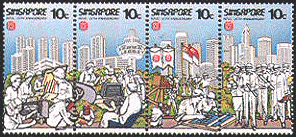Any significant political event today is often quickly marked by the release of a meme into cyberspace. These simple graphical messages seize on an event’s most controversial moments, translating it into a digital file of less than a hundred kilobytes. In a matter of seconds after its creation, a meme is shared and read, and if effective, its message spreads like wildfire through the Internet and is received by a global audience.
Such memes, often created with just a clever juxtaposition of a tagline on an image, is an act of graphic design as its most basic—combining graphics and text to create meaning. Just as how graphic designers often tap on popular culture to create an attractive visual language for communication, these memes also appropriate images from popular films and iconography to grab attention for its messages.
One could trace political memes to political cartoons, as both take on the subject by injecting humor to create a graphical product whose goal is to make its readers laugh, and often implicitly criticize. While political cartoons have had a long history and is considered a discipline in its own right today, memes looks much more raw in comparison and are often plain ugly. Yet, it is their Do-It-Yourself aesthetic, cobbling together seemingly disparate graphic elements, that gives it legitimacy as a message that originated from the grassroots. Political memes are not the works of a professional cartoonist nor is it a slick advertisement from a politician or group with an agenda—they are the voices of the masses for the masses, an online version of the political poster.
Unlike professional graphic designers, meme creators only need to know where to Google and appropriate the image that is best suited for the message in their heads. Sometimes, it is the reverse, becoming a game of who wrote the funniest caption. The rise of memes has been aided by the emergence of simple web tools that allows anyone to quickly ‘generate’ one and share it, using a series of templates that codify how a meme works. One signature form that is characteristic of the genre starts with a lead-in text, followed by a ridiculous but somewhat relevant image, and ends with a punchline for impact. This three-step design process shows how readers often encounter memes, while scrolling in the web browser environment.
Although there are more complicated memes that allow a longer narrative to be played out, such as those based on the design of comic panels, they are mostly short and to the point. The choice of publishing memes via social media also explains its design. Clearly catered for viral transmissions that ride on platforms filled with competing messages, the design of political memes prize speed and compactness over cutting-edge aesthetics and depth.
Political memes are essentially a fragment—and at times, not even the most important—of how the masses see politics today. This is perhaps a sign of how everything in our lives today take on a certain ‘entertainment’ turn—even something as serious as politics. With so many other things in life to do, politics has to be reduced to punchlines and attention-grabbing antics in real-life and also in the form of memes.
This political form that is born from the convergence of technology, design, and society has become so popular that there are now websites dedicated to the generation, collection and distribution of such memes. Even politicians have got into the game, when during the 2012 US Presidential campaign, both candidates’ social media teams unleashed their own memes into their World Wide Web.
This new form of political expression of the times is another medium of society’s democratic conversation, adding richness to the online chatter amongst the masses, and definitely a good laugh too. But is there anything more after that? On the one hand, it can serve a vigilante function, cutting through heavy political acts by seizing on dubious messages and magnifying them through humor, but on the other, political memes often takes things out of context, mostly for the sake of entertainment.
Just as how computers made visual expression simpler for more, the simplicity and ease of creating and distributing memes is another example of how graphic design is being democratized, in this case for online communication on political matters. And like most media, memes are value-free, but entirely up to where designers — in this case, citizens — want to take them.
——————
This was originally written for a graduate programme application.













